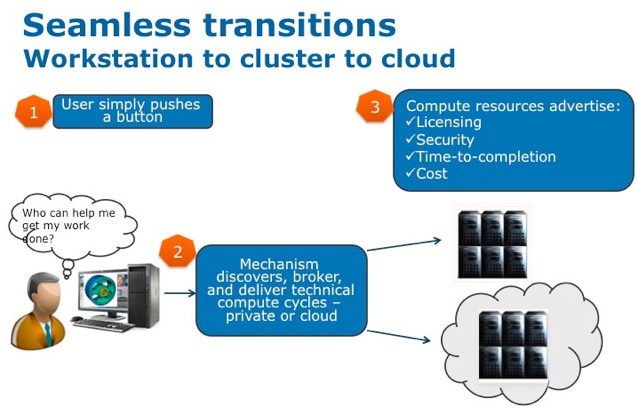Seamless Computing: A Conversation with John Hengeveld
John Hengeveld likes automotive analogies. "If you haven't got a car, you don't need an on-ramp," he says, a statement that makes perfect sense in the context of his vision of seamless computing and the efforts to bring high performance computing (HPC) to the "missing middle."
 Hengeveld is Intel's director of HPC marketing. One of his charters is to grow the use of HPC across a broad range of computational environments — from the desktop to the datacenter — and a broad class of users. The latter includes the missing middle, the nearly 300,000 small- to medium-sized US manufacturers (SMMs) who are not realizing the benefits associated with digital manufacturing — particularly the use of modeling and simulation to cut the time and costs associated with physical prototyping. At the moment, a variety of economic, social and technical barriers are in the way.
Hengeveld is Intel's director of HPC marketing. One of his charters is to grow the use of HPC across a broad range of computational environments — from the desktop to the datacenter — and a broad class of users. The latter includes the missing middle, the nearly 300,000 small- to medium-sized US manufacturers (SMMs) who are not realizing the benefits associated with digital manufacturing — particularly the use of modeling and simulation to cut the time and costs associated with physical prototyping. At the moment, a variety of economic, social and technical barriers are in the way.
Parsing the Missing Middle
In Hengeveld's view, the missing middle consists of three distinct groups, each with its own relationship to the adoption of advanced computational technology.
Group one is a relatively small subset of the SMMs. These manufacturers understand and use HPC, but are hard pressed to ramp up their computing capabilities because of economic barriers. Says Hengeveld, "They just don't have the capital to invest. Also, in many cases, the licensing models of the companies and ISVs they would like to work with do not allow them to scale out their work situation — the money required as well as a clear cut ROI to justify the incremental spend just aren't there."
He notes that big computer centers like Oak Ridge National Labs or the Ohio Supercomputer Center are reaching out to this group, inviting them to use their facilities at very reasonable rates and providing support services to help them run their jobs. A variety of HPC in the cloud solutions also address the needs of this group.
"Most of the initiatives targeting the missing middle are centered on group one," he says. "This is good — it's morally valuable — but it does not address the needs of a much larger group of small- to medium-sized businesses, including the SMMs."
This group, group two, does not really understand HPC, although they may be involved in technical computing. Some are using workstations and other desktop systems to run standard 2D CAD applications. The more adventurous are exploring 3D CAD and some FEA and CFD apps using software from companies like Dassault SolidWorks, Autodesk, Ansys, and Siemens.
But, for the most part, this group is not involved in advanced computing — the barriers to adopting HPC are too severe. In addition to the economic considerations that they share with group one, SMMs in group two lack the requisite in-house technical skills for HPC — skills such as parallel programming expertise, the ability to provision multicore systems, and all the other arcane knowledge required to deal with complex high-performance systems. They see themselves as product designers, manufacturing engineers, industrial researchers — not as advanced computing specialists. Also, culturally they are not inclined to abandon current practices, such as physical prototyping, and take the risks inherent in implementing an HPC cluster or using the facilities of a supercomputer center to conduct advanced modeling and simulation.
Finally there is group three, another sizable segment of the missing middle that neither understands (or even cares about) HPC and is not involved in technical computation. This portion of the missing middle, estimated by Addison Snell, CEO of Intersect360, to be about half of the total, is liable to remain missing for some time to come.
Despite these barriers, all three groups are candidates for an assist from HPC. The trick is to deliver these services in an affordable, user-friendly way that allows the SMMs to enjoy the benefits of advanced computing without getting mired down in the technology or overwhelmed by escalating expense. There should also be compelling incentives for ISVs to offer these capabilities to their manufacturing customers. Part of the answer is what Hengeveld refers to as "seamless computing."
Seamless Computing to the Rescue
Still in its conceptual stage, seamless computing will probably use some subsets of cloud-based solutions to provide services and the applications that draw on these services in a more standardized model (see the figure below).

"Seamless computing targets the first and second groups," Hengeveld notes. "This approach provides more visibility into the service offerings that are available, as well as their differentiation and pricing. This allows the potential user to make informed choices based on overall ROI.
 "Group one users have a high performance sports car with a manual transmission that can go 250 mph," he says. "They already know how to drive a high performance vehicle. Now they need the best roads to take them to their destination. So seamless computing provides them with the equivalent of a Garmin GPS; it knows all about all the surrounding roads and plots an optimized value route to get where they want to go."
"Group one users have a high performance sports car with a manual transmission that can go 250 mph," he says. "They already know how to drive a high performance vehicle. Now they need the best roads to take them to their destination. So seamless computing provides them with the equivalent of a Garmin GPS; it knows all about all the surrounding roads and plots an optimized value route to get where they want to go."
Continuing the automotive metaphor, Hengeveld says that group two members are stuck on the surface streets in everything from pickup tricks and minivans to VW Beetles and MiniCoopers. Seamless computing not only shows them a network of roads and super highways that they never knew existed, but points them to the nearest on-ramp.
Group three represents a special challenge. They are not doing technical computing, even though, unbeknownst to them, it would help their business and bottom line a lot. Here is the challenge for the ISVs and workstation community — how to ease this subset into running digital manufacturing applications without totally disrupting the way they are already working. For group three, at this stage seamless computing doesn't help — no car, no need for an on ramp.
Hengeveld formally defines a true seamless computing solution as a set of mechanisms by which compute capability makes itself visible by standard means, for which discovery engines can determine the accessibility of global resources.
It's important to clearly delineate each available compute resource. Clouds are just one of those resources; others include clusters, leadership class supercomputing systems, or an aggregation of workstations such as Intel's pilot program known as Cubicle Clustered Computing (CCC).
With CCC, the workstations, configured to mimic the servers they would normally access, are placed in the individual engineer's cubicles. The can be combined into clustered environments, providing HPC performance for companies that don't have the available datacenter space or the expertise to build a specialized HPC environment.
A Question of Self Perception
"We have a marketing identity problem to overcome," Hengeveld adds. "These group one and two members don't think of themselves as HPC users — they identify themselves as ANSYS designers or AutoCAD guys. They say 'If you give me a new tool, I'll try and figure out how to use it. If I can't, I'll work with what I have.' So the question becomes, how do you get them to make the transition to this superhighway that we are envisioning?"
 First these folks need a fast enough car that will not only allow them to survive the journey, but also get them where they're going quickly and efficiently. And they shouldn't have to worry about the automobile's internal operations.
First these folks need a fast enough car that will not only allow them to survive the journey, but also get them where they're going quickly and efficiently. And they shouldn't have to worry about the automobile's internal operations.
In seamless computing, the hard decisions about allocation of resources and other key compute factors are based on policy decisions made for the user by the IT organization. The whole process is highly transparent to the user who literally just pushes a button — a concept similar to the wireless Internet. The system's metadata exposes services that provide HPC capability by tapping into interoperable resources ranging from public and private clouds to clusters and supercomputers. For all three SMM groups, the ultimate benefit is seamless access to optimum compute resource resulting in lower costs, increased productivity, and heightened competitiveness.
Making it Happen
"We are taking action on this," Hengeveld reports. "Working with our partners such as HP and other OEMs, as well as university centers and service providers, we are exploring the architectures that will be required to make seamless computing a reality. The first step is to agree on standards for exposing the metadata. Next we need to agree on a standard definition of an environment that will allow ISV to write applications that will produce reliable performance from the architecture's clusters, clouds or supercomputers. Then we can determine how to encapsulate decision making from an IT policy-making standpoint into some means of brokerage. The ISV's play a key part in rolling out these kinds of services. Plus, they stand to greatly benefit from the creation of standardized landing zones that will reduce their costs and allow them to provide their customers with real value. Profitability will inevitably follow.
"We will continue our meetings with people in industry, government and academia about seamless computing and enlist widespread support," he says. "By this fall we should have enough momentum generated to determine how we can best move forward."










